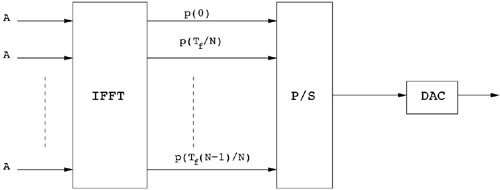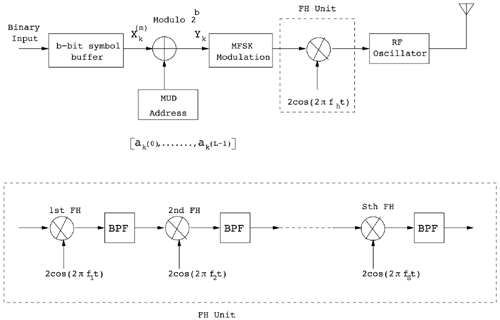Section 5.4. MC-UWB Transmitters
|
5.4. MC-UWB TransmittersIn multicarrier systems, a single data stream is split into multiple parallel data streams of reduced rate, with each stream transmitted on a separate frequency (subcarrier). Each carrier is modulated at a low enough rate to minimize intersymbol interference (ISI). Subcarriers must be properly spaced so that they do not interfere. For a N subcarrier system, each subchannel is tolerant of N times as much dispersion as the original single carrier system. Multicarrier UWB (MC-UWB) communication systems use orthogonal UWB pulse trains and multiple subchannels to achieve reliable high bit rate transmission and spectral efficiency [28]. Some of the advantages of MC-UWB systems are better time resolution, which leads to better performance in multipath fading channels; better spectrum utilization, which leads to higher bit rate communications; and simple decoupled system design, which leads to a simple transmitter implementation. We briefly describe the transmitter for MC-UWB system here. The binary MC-UWB transmitted signal can be represented as Equation 5.22 where 5.4.1. CI-UWB SignalsIn [29] the use of a multicarrier Carrier Interferometry (CI) waveform as a means to enable higher throughput/improved multiaccess in UWB (without significant performance degradation) is proposed. Interferometry [30], a classical method in experimental physics, refers to the study of interference patterns resulting from the superposition of waves. The presence of distinct peaks and nulls in the interference patterns has motivated the widespread use of interferometry. The ideas underlying interferometry lend themselves naturally to multiple access applications in telecommunications. For example, in antenna arrays supporting space division multiple access, electromagnetic (EM) waves are emitted simultaneously from multiple antenna elements and initial phases are chosen to ensure that interference patterns create a peak at the desired user location and nulls at the position of other users. CI methods have initially been studied in [29], [31], and [32]. The CI pulse waveform in UWB corresponds to the superpositioning of N orthogonal carriers. The idea is that with carefully chosen phase offsets (spreading codes) that ensure a periodic main lobe in the time domain (with side lobe activity at intermediate times) we could null out ISI, MAI, or any other form of interference. At the receiver side, the received UWB CI signal is decomposed into carrier components and recombined to exploit frequency diversity and minimize ISI/MAI from other information bearing pulses. We briefly describe the TH-UWB, CI-UWB transmitted signal. The transmitted signal for user k, k = 0, 2,..., K - 1 in a multiaccess scenario (or the kth bit per frame in a high bit rate scenario) is Equation 5.23 where m is the index indicating the frame number (each frame is of duration Tf), the sum over m is the sum over all frames of duration Tf, and skm (t) is user k's transmitted bit in the mth frame Equation 5.24 where Equation 5.25 CI is an alternative for UWB pulse shaping and corresponds to the superposition of carriers equally spaced in frequency by Equation 5.26 The CI signal given above is constructed via an N-point IFFT. Specifically, we have Equation 5.27 This corresponds to the k value in the N-point IFFT shown in Figure 5.26. Figure 5.26. CI-UWB Transmitter.SOURCE: Z. Wu, F. Zhu, and C. R. Nassar, "Ultra Wideband Time Hopping Systems: Performance and Throughput Enhancement via Frequency Domain Processing," 36th Asilomar Conference on Signals, Systems and Computers [48]. © IEEE, 2002. Used by permission.  The frequency based processing of CI pulses in UWB systems enables high throughputs while maintaining excellent BER performance. This idea has been extended to CI-DS-UWB [33]. 5.4.2. FH-UWB SystemIn [34], a residue number system (RNS) assisted multistage frequency hopped spread spectrum multiaccess scheme is studied. We refer to this system as FH-UWB. This FH-UWB scheme is capable of efficiently dividing a huge number of users into a number of reduced-size user groups. Note that multiuser interference only affects users within the same group. Because the number of users within the same group is only a small fraction of the total number of users supported by the synchronous FH-UWB system, advanced multiuser detection algorithms can be employed to achieve near single user performance at an acceptable complexity. The following are some of the advantages of FH-UWB systems over DS-UWB systems:
In Figure 5.27, the transmitter block diagram of a FH-UWB system employing MFSK modulation is shown. Readers are referred to [32] for details and a description of the transmission mechanism. We present the figure in this section for the sake of completeness. Figure 5.27. FH-UWB Transmitter. 5.4.3. OFDM-UWB SystemOFDM is a special case of multicarrier transmission that permits subcarriers to overlap in frequency without mutual interference, resulting in increased spectral efficiency. OFDM exploits signal-processing technology to obtain cost-effective means of implementation. Multiple users can be supported by allocating each user a group of subcarriers. OFDM-UWB is a novel system that has been proposed as a physical layer for high bit rate, short-range (10 m-20 m) communications networks in high performance computing clusters. The OFDM-UWB transmitter relies on splitting orthogonal subcarriers into a train of short pulses, sending them over a channel, and reassembling them at the receiver to get orthogonality and to recover each sub-carrier separately [35], [36]. This new system offers more flexibility in shaping the transmitted spectrum because it has more degrees of freedom than a single carrier system. OFDM-UWB provides more multipath resolution than single carrier UWB. Unlike narrowband OFDM, a given tone in OFDM-UWB is transmitted only during parts of the transmission interval. Reliable communication results from integrating several pulses and high throughput from transmitting frequencies in parallel. Unlike narrowband OFDM, the OFDM-UWB spectrum can have gaps between subcarriers. Another major difference between OFDM-UWB and narrowband OFDM is their spectral shapes. OFDM-UWB is being proposed as the physical layer standard in 802.15.3a Wireless Personal Area Networks [37]. See Appendix 10.B for a detailed description and block diagram of this physical layer standard. OFDM-UWB is a MC-UWB system that uses a frequency coded pulse train as a shaping signal. The frequency coded pulse train is defined as follows Equation 5.28 where s (t) is an elementary pulse with unit energy and duration Ts < T . p (t) has duration Tp = NT. Each pulse is modulated with a frequency Equation 5.29 Because Equation 5.30 are orthogonal for k = 0, 1,..., N - 1. Further, if Ts = T, the signals given by (5.30) are orthogonal for any k. Costas showed that if c (n) is a Costas sequence, the pk (t)'s remain near-orthogonal under different multipath delays. Further, (5.30) can be efficiently implemented by taking samples of the signal p (t), which are IFFT samples, and passing them through a DAC. The most challenging part of this structure is designing the DAC. In these structures, DACs typically operate around hundreds of MHz. In the next section, we describe OFDM-UWB using sigma-delta modulators that trade off the high operating rate of DACs for lower resolution. N-Tone Sigma-Delta OFDM-UWBA new method for generating and detecting the OFDM-UWB signal using a modified sigma-delta modulator is proposed in [38], which is an improvement of the existing OFDM-UWB system discussed in Section 5.4.3 for high data rate applications. Unlike narrowband OFDM, IFFT/FFT cannot be directly used to generate and receive OFDM-UWB signals because of the high bit rates involved. To solve this problem, a procedure to move the bulk of the processing load from analog devices to the digital base band section is described in [38]. Sigma-Delta A/D and D/A converters are a good choice for high bit rate wireless communications [39]. Traditional versions of the sigma-delta modulators cannot be used in OFDM-UWB transceivers because they would require prohibitively high sampling rates. A sigma-delta modulator modified to fit the characteristics of OFDM-UWB signals is proposed that enables most of the processing to be done digitally in both the transmitter and receiver. This approach efficiently uses the IFFT/FFT algorithm to generate and demodulate OFDM-UWB signals and also gets rid of the high peak-to-average ratio (PAR) problem that occurs with OFDM systems. The modified sigma-delta modulator, called the N-tone sigma-delta modulator, introduces N zeros at the frequencies in the quantization noise spectrum. These zeros match the locations of frequencies used by the OFDM system, and the quantization noise spectrum fills the gaps in the spectrum of the OFDM-UWB signal. In fact, this new structure can be used in other UWB systems any time there are gaps in the spectrum of the transmitted signal. However, these advantages come at the expense of lower spectral efficiency. The N-tone sigma-delta quantizer structure is shown in Figure 5.28. A transmitter structure for generating UWB-OFDM signals using the sigma-delta modulator is shown in Figure 5.29 [40]. Figure 5.28. N-tone Sigma-Delta Modulator.SOURCE: E. Saberinia and A. H. Tewfik, "N-Tone Sigma-Delta UWB-OFDM Transmitter and Receiver," IEEE International Conference on Acoustics, Speech and Signal Processing [39]. © IEEE, 2003. Used by permission.  Figure 5.29. OFDM-UWB Transmitter with N-tone Sigma-Delta Modulators. |
|
EAN: 2147483647
Pages: 110






